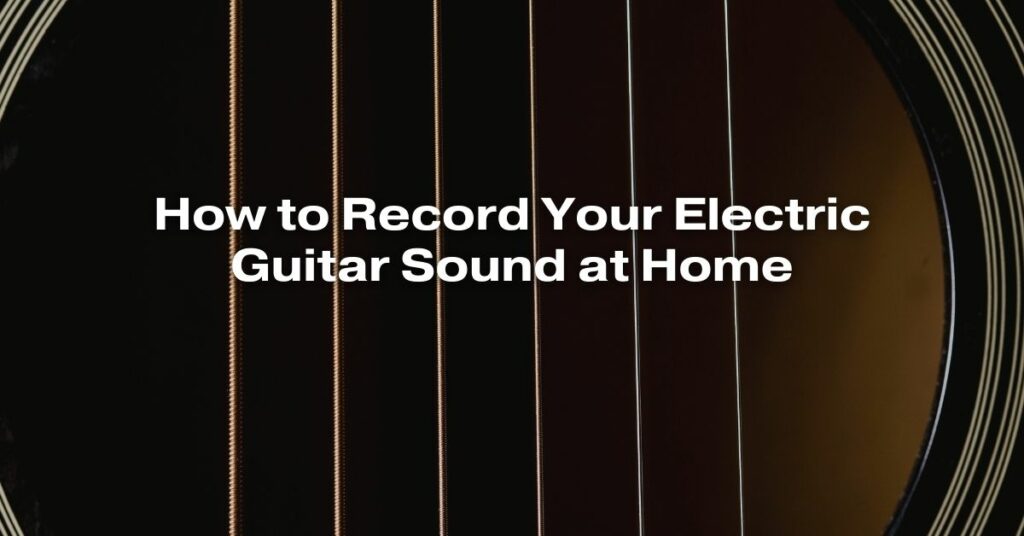In the digital age, recording your electric guitar sound at home has never been more accessible. Whether you’re a budding musician, a seasoned player, or simply someone who enjoys tinkering with sounds, having the ability to capture your guitar’s essence is essential. With advancements in technology, creating professional-quality recordings from the comfort of your home is not just a possibility, but a practical reality. This comprehensive guide will walk you through the process of recording your electric guitar sound at home, covering everything from the essential equipment to recording techniques and tips for achieving that perfect sound.
I. Essential Equipment
1. Electric Guitar:
Begin with a high-quality electric guitar that suits your style and preferences. The type of guitar you choose significantly impacts the overall tone of your recordings.
2. Amplifier:
Invest in a good amplifier that complements your guitar. The amplifier is crucial for shaping your guitar sound before it’s recorded.
3. Audio Interface:
An audio interface serves as the bridge between your guitar and your computer. Choose an interface with sufficient inputs and outputs, high-quality preamps, and low latency for smooth recording.
4. Digital Audio Workstation (DAW):
Select a DAW software such as Ableton Live, Pro Tools, or Logic Pro X. DAWs enable you to record, edit, and mix your guitar tracks.
5. Microphones:
Consider using microphones to capture the sound of your amplifier. Dynamic microphones like the Shure SM57 are popular choices for miking guitar amps.
6. Cables and Accessories:
Ensure you have high-quality instrument cables, microphone cables, and necessary accessories like mic stands and pop filters.
II. Setting Up Your Home Studio
1. Guitar Setup:
Ensure your guitar is properly tuned and set up. Clean your guitar and change strings if needed for optimal sound quality.
2. Amplifier Settings:
Experiment with different amp settings to find the tone you desire. Adjust the gain, EQ, and effects to achieve the sound you want to record.
3. Room Acoustics:
Consider the acoustics of your recording space. Use rugs, curtains, and foam panels to minimize unwanted echoes and reverberations.
4. Microphone Placement:
Experiment with microphone placement to capture the best sound from your amplifier. Move the microphone around the speaker cone to find the sweet spot.
III. Recording Techniques
1. Direct Recording:
Connect your guitar directly to the audio interface for a clean, unprocessed sound. This method is ideal for using amp simulators and virtual effects in your DAW.
2. Amp Miking:
Place a microphone in front of your amplifier to capture the natural sound. Experiment with different mic positions to find the perfect balance between the amp’s speaker and the room ambiance.
3. Layering and Double Tracking:
Experiment with layering multiple guitar tracks to create a fuller sound. Double tracking, where you record the same part twice and pan the tracks left and right, adds depth and richness to your recordings.
IV. Tips for Achieving the Perfect Sound
1. Practice and Preparation:
Practice your guitar parts thoroughly before recording. Well-rehearsed performances make the recording process smoother and result in better-quality tracks.
2. Experiment with Effects:
Don’t hesitate to experiment with different effects pedals and plugins. Effects like reverb, delay, and modulation can add character to your guitar sound.
3. Pay Attention to Timing:
Ensure your playing is in time with the backing track or metronome. Tight rhythm and precise timing are crucial for professional-sounding recordings.
4. Mix and Edit Carefully:
Take your time to mix and edit your recordings. Balance the guitar tracks with other instruments, apply EQ, compression, and other effects judiciously to enhance the overall sound.
5. Seek Feedback:
Don’t hesitate to seek feedback from experienced musicians or audio engineers. Constructive criticism can help you refine your recording techniques.
Conclusion
Recording your electric guitar sound at home is a rewarding experience that allows you to unleash your creativity and share your music with the world. With the right equipment, setup, techniques, and a dash of creativity, you can produce high-quality recordings that capture the essence of your playing style. Remember, practice and experimentation are key. So, plug in, play around, and enjoy the process of creating your unique guitar sound in the comfort of your home studio. Happy recording!


